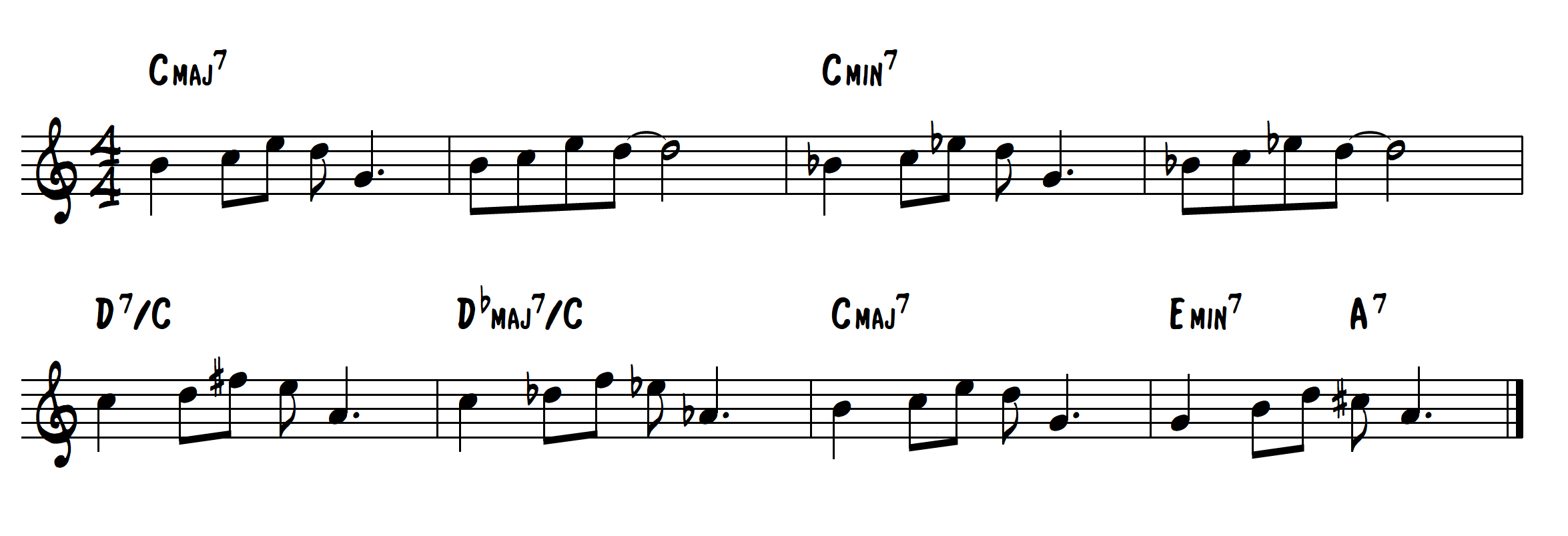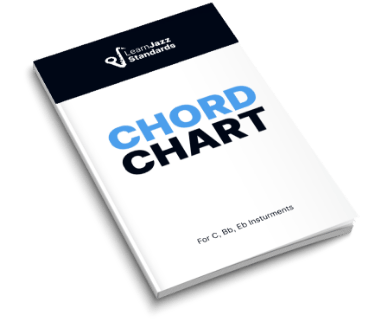Welcome to episode 108 of the LJS Podcast where today we are concluding “Jazz Standards Month” with the topic of motivic development and how we can utilize it to develop musical themes, and structure into our jazz solos. Brent tells you what motivic development is and gives some examples. Listen in!
Listen to episode 108
This week’s episode concludes “Jazz Standards Month” where we’ve been digging into different strategies for approaching and understanding jazz standards.
I talk all about motific development, what it is, and how to use it over any kind of chord progression. Specifically, I hone in on the first 8 bars of On Green Dolphin Street, which can be a bit tricky to approach.
I draw this lesson from the upcoming April 2018 release of our brand new eBook and companion course, The Jazz Standards Playbook, which goes over in-depth studies of 10 important jazz standards and what we can learn from them.
Motivic development is when rhythmic or melodic ideas are repeated or evoked over different structures within a composition. This often manifests in applying the same or similar rhythmic ideas over different chords in a progression. It can also be the same or similar note choice formulas applied over the different chords.
Here is some of what I talk about in today’s episode:
-
What a motif is and how it can help.
-
2 examples of motifs and how to understand them.
-
My challenge for you to compose your own motifs.
Remember this week to take action. Understanding and knowing this concept is a great thing, but until you take action on it, you won’t have gained its benefits.
Musical Examples:
 Important Links
Important Links
The Jazz Standards Playbook[vc_separator]
Free Guide to learn standards by ear: Learn Jazz Standards the Smart Way
Read the Transcript
Brent: All right, podcast listeners, what’s up? My name is Brent. I am the jazz musician behind the website LearnJazzStandards.com, which is a blog, a podcast, and videos all geared toward helping you become a better jazz musician. Welcome back to the regular listeners and those of you listening for the very first time. If you are a jazz geek or a musician or someone who wants to be a better player, you are in the right place, so stay around, stick around. Now we are closing up Jazz Standards Month, the month of March has been Jazz Standards Month. And we’re closing that up today with a great episode, episode 108, which is all about using motivic development to help you develop themes in your jazz solos. And this episode, we’re gonna be talking about what is motivic development, how can it help us, and I’m gonna be giving you some examples as well, so stick around, make sure you stay tuned.
Now, Jazz Standards Month, if you’ve been listening for a while, for the last several episodes, you know that this is leading up to a big book launch, ebook launch and companion course, the Jazz Standards Playbook. Which the official date now is April the eighth, Sunday, April the eighth, 2018, is when this book is coming out.
Super stoked about this, this is a book that goes into depth into 10 jazz standard studies where, of course, these jazz standards are important to know, but they also have tons of lessons to teach us about jazz, about harmony, about music theory, about improvisation, that if we can unlock these and get inside of these, we can really unlock hundreds of other standards.
So I’m really excited about this book, it’s gonna be launching, now if you want to be the first to know about this book coming out, which I encourage you to do so, if you think that this is something that could be right for you, I want you to go to TheJazzStandardsPlaybook.com and sign up to get early notification. TheJazzStandardsPlaybook.com.
Now, one last thing before we jump in today’s show here. Last week I invited you to become a member of our LJS community Facebook group. We started that up, it’s only been around for a couple weeks now, and we already have over 1,000 members. And there’s a lot of incredible, great conversations happening. So if you want to connect with those who listen to this podcast and those who are subscribers to the Learn Jazz Standards newsletter, if you want to connect with all these different musicians, go there. It’s a closed group, so you’ll have to ask to be added. There’s a couple of questions I have for you, and then I’ll let you into the group. And you’ll join the rest of us. It’s a fun party, so if you want to get involved in the Facebook group go to LearnJazzStandards.com/community. Love to see you inside there.
Okay, without further ado let’s jump into today’s show.
All right, today’s episode is all about motivic development. Motivic development, this is a great technique that can be used to develop themes in your improvisation. Now, oftentimes I find that, and I find this in myself too, as well. I can’t just say that I’m not guilty of this sometimes too. I find that it’s easy for musicians, for our tendency to be to play a bunch of different ideas that aren’t necessarily always connected with each other when we get up to do a solo, whether it be in jazz, whether it be any other kind of music. The temptation is to play idea after idea in an endless stream of notes, right? We want to fill in that space, we want to keep the ideas flowing, right?
Well, sometimes we forget, though, that we need to be developing themes in our solos, in our improvisation, to make a big impact on our listeners and of course on our other bandmates as well. So there’s a lot of ways we can practice this, but I find a great way to practice this is to develop motifs. Now, what is a motif? Here’s a definition for you. In music, a motif is a short rhythmic or melodic passage that is repeated or evoked in various parts of a composition. Okay, repeated or evoked in various parts of a composition. Now, this means that we’re not just going from idea to the next idea to the next idea. We’re taking a theme, a rhythmic theme or even a melodic idea, and we’re repeating it over the harmonic context that we are presented with. And we might have chord changes going by, different chords going by, but we may still be sticking to a specific kind of rhythm or a specific pattern that we’re dealing with.
So there’s all kinds of different kinds of motifs, but the idea is that we’re staying in this general theme. And not only does this created themes in our solos, it actually also challenges us to take some melodic or rhythmic information and translate it … there’s the key word right there … translate it into a different key or a different quality of chord. Maybe you’re playing a harmonic idea, a melodic idea, over a major 7th chord, but then that chord changes into a minor 7th chord. And then how are you going to translate that same idea into that different quality of chord, possibly in a different key, or a different quality of chord? Does that make sense? So motif in music is a short rhythmic or melodic passage that is repeated … whoa, or evoked in various parts of a composition. I feel like I can’t read today.
So this lesson where I talk about motifs, this comes out of our new ebook that’s coming out soon, the Jazz Standards Playbook, and specifically, we apply this improv lesson over the top of the jazz standard “On Green Dolphin Street.” ‘Cause, now, “Green Dolphin Street” has a lot of great lessons to teach us, but specifically, those first eight bars are kind of … they’re interesting harmonically. What’s happening there? That’s the big question a lot of people have. Now, I’m gonna use an example. You know, “On Green Dolphin Street,” the common keys are concert C and concert E flat. At least that’s what I find most jazz musicians are playing that song in. So it would go like this, it’s really the first eight bars that I’m gonna hone in on today. It starts with the CM7 … (Musical Example Playing) … so the Cm7 to the D7, DbM7, right? Okay, so it’s this part.
(Musical Example Playing)
Okay, actually that was a little more than the eight bars I talked about. I’m just talking about the CM7, Cm7, D7, and then the DbM7. Okay, those are the chords I’m talking about. So really quickly, what’s happening here? We start on the root, this is the key center, the parent key center of C major, CM7. Now that turns into a Cm7. You can almost think of it as we’re going into the minor key now, the parent minor key of C minor. Okay, what’s the difference between a major 7th chord and a minor 7th chord? The flat three and the flat seven make up the minor chord. So we’re flatting the three, flatting the seven. So one bar of CM7, two bars rather, and then two bars of Cm7. Then D7. Now, usually this is played over a pedal, so there’s a C in the bass for all of these chords. But D7 over C, and then DbM7 over C, then CM7.
So the big question that people always have is, once we get past the Cm7, thinking of that as the I minor chord, if you want to think of it that way, you get to the D7, which, now, Dm7 would be the II chord in C major, right? But we’re changing it to a dominant 7th chord. Now, in jazz this is not all that weird. This is normal, to turn a minor 7th chord to a dominant 7th chord. You can do that, and this happens all the time, jazz musicians turning minor 7th chords into dominant 7th chords. So that’s not necessarily so weird. We’re just, instead of a minor 7th chord we have a major 3rd in there. So CM7, Cm7, D7, that’s the dominant II chord, but this is the one that gets people, DbM7. What’s that doing there? And then it resolves to a CM7.
Couple ways to think of that DbM7, and let’s go over them really quick. The first one is it’s a sort of tritone substitution. Now, we’ve talked about tritone substitutions on this show before, but just a little review for those who didn’t listen to that show or don’t know what it is already. Tritone substitution is simply taking … and normally, this is the case, it’s taking a dominant 7th chord and replacing it with another dominant 7th chord a tritone interval away. This is … so in other words, if we’re in the key of C, we have a II chord, it’s D7.
Well, normally to get to that C we would connect it with the V chord, which is G7, okay? So it would be D7, or Dm7, to G7, to CM7. Well, tritone substitution says we’re gonna replace that G7 a tritone away. And a tritone away … that’s the sound of that interval … is Db. But it would be a Db7. So normally it would be a D7, Db7, CM7. That would be a proper tritone substitution. Well, in this case that’s not what’s happening. It’s a tritone away, the root is, but it’s a major 7th chord rather than the dominant 7th chord.
So you can think of it as a type of tritone substitution, a D7 and then a DbM7 to substitute the G7, to a CM7. Now, the second way to think about this is to think of it as just a passing chord. You know, we have basically descending roots going on here. We have a D7 as the II chord, Db7 to the CM7. So it’s really just a passing chord in between. Either way, it’s not worth getting hung up over. The important thing is to realize what are the difference in notes between all of these, right? You have to kind of map out these notes. We talked about mapping last time, you know, arpeggiating all this stuff, finding the different tones in these chords that really make the difference using guide tones, all that stuff is really important for identifying these.
So to sum up, we have CM7 for two bars, that’s the parent key center, the tonic. To Cm7, we’re basically insinuating a new tonic, it’s the C minor, we’re in a new key, rather. Okay, so C minor. Now, D7, DbM7, you can think of it as a tritone sub or a passing chord, either one, to CM7, okay? So that’s what we’re dealing with here. So how do we approach these chords? Because this isn’t like typical diatonic harmony going on here. It’s not typical, so we have different things going on here. I mean, this isn’t II-V-Is, I-VI-II-Vs, III-VI-II-Vs, stuff that we’re used to in jazz harmonies, cycling in fourths. It’s working a little bit differently.
So the way I do it in the Jazz Standards Playbook is I draw the lesson of motivic development to help us simplify this chord progression by, rather than trying to take a bebop approach to this, you know, playing these chord changes, spelling them out the way a bebopper would, it’s just taking simple rhythmic and melodic ideas and repeating those same ideas over the different chord changes. So let me play for you an example of a motif, a motif that is repeated over these first eight bars of “On Green Dolphin Street.” So here’s the first one I want to show you.
(Musical Example Playing)
So if you want to see this example and all the examples that I’m going to show you today notated out, you can go to the show notes, LearnJazzStandards.com/episode108 if you want to check that out. But here’s what’s going on here, whether you’ve got the show notes or not. The rhythmic structure for the two bars that are spent on each chord, well, at least the first four bars, are quarter note, three eighth notes, and a dotted quarter note. And the second bar is four eighth notes tied to a half note. So the last eighth note is tied to a half note. And the chord tone structure is this. It’s seventh, root, third, nine, five. Okay? Seven, root, third, nine, five. That’s the first bar, and the second bar is similar. It’s seven, root, third, and nine.
Just ends on the nine. So … (Musical Example Playing). Seven, root, third, nine. So seven, root, third, nine, five. Seven, root, third, nine. Okay?
Now, the same thing, that’s over a CM7. Now, over the Cm7, it’s the exact same thing, the exact same rhythm. Seven, root, third, nine, five. Except for now it’s Bb, that’s the seven, right? Root is C, Eb is the third now, D is still the nine, and G is still the fifth. So seven, root, third, nine, five. Seven, root, third, nine at the end there. So seven, root, third, nine, five. Okay? See how that works? It’s the exact same structure and the exact same rhythm. Now, when we get to the D7 over C and the DbM7 over C, we’re doing basically the quarter note, three eighth note, and dotted quarter note rhythm, and it’s the same formula, though. It’s seven, root, third, nine, five.
So in the case of D7, it’s seven, which is C, root, D, third, which is F#, nine is E natural, five is A. That’s a dotted quarter note. So it’s … (Musical Example Playing). Okay? That’s over D7. Now, over the DbM7 we’ve got to adjust for the chord now, right? So the seven is actually still C, right? C, and then root is Db, so a half step up. So seven, root, and then F natural is the third, so … (Musical Example Playing). And then Eb is the nine, and Ab is the fifth. So … (Musical Example Playing). Oops. (Musical Example Playing). So we have … (Musical Example Playing). Okay? See how that works? Now, you hear the difference in those chords, right? But all we’re doing is we’re taking the same formula and repeating it over all those chords. See how helpful that is? Now, obviously, in practice this is a little bit robotic. It’s not necessarily 100% musical. But if we can practice this way, practice this technically, it can help us actually apply this in real musical situations. So much value in here.
Now, I don’t want to spend forever on this episode. I want to keep it a little bit short and sweet because I think that this idea is fairly simple, and it’s more that I want to call you to action to actually practice this this week. So I’m gonna move on to the next one. Here’s another motivic idea, and then we’re gonna check it out and I’ll talk about it.
(Musical Example Playing)
Now, the reason I want to show you this one is because it is a little less formulaic and possibly a little more musical. In other words it’s kind of generally following a formula, it’s a rhythmic structure and yeah, a little bit of a formula with the chord tones, but it’s actually messing with them a little bit to adjust for each one, and trying to target different extensions. So that’s why I want to show you this one. So let’s talk about it really quick.
First of all, rhythmically, the general rhythm is four quarter notes, rather eighth notes. Four eighth notes with a half note tied at the end for the first measure. The second measure starts with a quarter note rest and then another four eighth notes tied with a quarter note at the end, and that’s the first four bars, follows that rhythmic formula. The last four bars, where the D7, the DbM7, the CM7 happen, it’s four eighth notes with a tie on the last eighth note to another eighth note, and then another eighth note. So that’s confusing. It’s six eighth notes but there is a tie on the fourth eighth note to the fifth eighth note, okay? Does that make sense? And it follows that formula. Again, you can check this out on the show notes if that’s confusing.
But let’s go to the CM7. So actually what we have here is a three, 13, seven, five formula. Okay? So E natural, A natural, B natural, G natural. And the second measure’s a quarter note rest, and then it goes seven, 13, five, three. So in total it’s … (Musical Example Playing). Okay? Now we’re switching to a Cm7 chord, but actually this time we’re targeting a Cm11. So it’s a Cm11 chord. I’ll tell you why. We have Eb, which is the flat three, and then we have G, which is the five, Bb, which is the flat seven, and then F, which is the 11. So … (Musical Example Playing). That outlines a Cm11 chord. And then the last, the second measure of that phrase there, is Bb, G, F, Eb. So seven, flat seven, five, 11, three. Okay? See how that works? Now let’s go to the D7.
Well, actually, hold on, let’s talk about that for a second. So what changed there, what was the difference? Well, instead of targeting the 13th like we did in the CM7, we were targeting the fifth. So we switched those out, and then the last ending note there, we decided, was an 11th, the F, as opposed to the fifth, which it was on the CM7. So we just changed it up a little bit, just different colors and sounds going on there.
Now, over the D7 we have something a little different. We have F#, A, C, B, A. What is that? That is three, five, flat seven, 13, five. It’s kind of bluesy, right? (Musical Example Playing). That’s the rhythm. Now we’re going down to the DbM7. We have F natural now, Ab, C, Bb, A. Exact same formula, three, five, seven, 13, five. So … (Musical Example Playing). All right, does that make sense? So we’re taking a general idea, but we’re tweaking it a little bit for musical taste. So one more time, this is what it sounds like.
(Musical Example Playing)
So to summarize, this is a great way to break things down, to chop things down, to find those notes that really differentiate each chord from each other, and to just find rhythmic and harmonic, melodic ideas that make sense, that you can repeat over top, and will help us develop themes. So here’s my challenge for you. I want you to take action on this week. Try developing a couple of your own motivic ideas over top of the first eight bars of “On Green Dolphin Street,” okay? You in for it?
All right, that’s all for today’s show, and I thank you so much for listening, and thanks for tuning in. Shorter but sweet episode of the LJS podcast. Now, if you found value out of this show as I always ask, please leave a rating and review, some kind words for the podcast on iTunes. So you can just go to iTunes, leave a rating and review, that really helps us out, helps other people find the show and let them know that this is a show worth listening to. Remember, if you like some of this stuff we’ve been talking about this month in the Jazz Standards Month, be sure to go to TheJazzStandardsPlaybook.com and sign up for early notification for when our new ebook, the Jazz Standards Playbook and companion course comes out. I’d love to have you involved in that, and very excited about this book.
Now, we’ve been doing a lot of solo shows lately. And I hope you’ve been enjoying them, but I love having guests on the show, and so we are gonna be coming back strong with guests pretty soon here, upcoming in next week’s episode, 109, we are gonna be jumping right back in to guests. We’re gonna be having special guest Brett Pontecorvo, who is my engraver. Now, what’s an engraver? An engraver is someone who helps you edit and notate music, make sure everything’s lined up, make sure that all the notation is correct.
And he was the engraver for my book, he is a professional at this. He’s also been on the show before to talk about sight-reading, but he has a lot of amazing stuff to talk about, and we’ve never done a show on how to notate music, how to do it properly, tips, tricks, tools of the trade. So I’m excited to have him on the show next week in episode 109. I’ll see you back then.




 Important Links
Important Links






